
Triptych of the Assumption of the Virgin (1462-3)
Duomo, Pienza
The origin of the nickname of this artist, il Vecchietta, is unknown. He was born near Siena, and was documented as a painter there in 1428. He was also an accomplished sculptor and miniaturist. His earliest documented work as an independent artist began in 1441 in the Ospedale di Santa Maria della Scala, Siena and lasted for some ten years.
Like other Sienese artists, il Vecchietta benefitted from the election of the Sienese Pope Pius II in 1458. Pius II he rebuilt his native village of Corsignano as an ideal city, which he renamed Pienza and gave it episcopal status. He commissioned four altarpieces from Sienese artists for the principal altars of the new cathedral at Pienza: these included the Triptych of the Assumption of the Virgin (1462-3 - illustrated above) by il Vecchietta.
Pienza became the summer home of the papal court under Pius II, and it was probably during il Vecchietta’s sojourn there that he met Cardinal Berardo Eroli. This probably explains the work by il Vecchietta for Eroli’s native Narni (see below).
Narni
St Bernardino of Siena (ca. 1462-3)
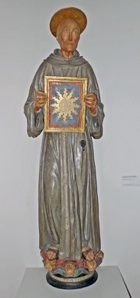
OPUS LAVRENTI PETRI PICTORIS SENENSIS
(the work of Lorenzo di Pietro, painter from Siena).
Its existence in what is now the Eroli Chapel, San Francesco, was documented in a recently discovered bull (1464) in which Pope Pius II granted indulgences to those visiting the chapel, which was at that time dedicated to St Bernardino of Siena. It is likely that Cardinal Berardo Eroli secured the indulgences and commissioned the statue.
The statue was documented again in this chapel in 1659, when it was surrounded by now-lost figures (either painted or sculpted) of SS Louis of Toulouse and Antony of Padua. It was documented in the chapel in 1747,and was subsequently moved to San Giuseppe. It was documented there in 1872 and 1896. It entered the museum in Florence in 1910.
The statue depicts St Bernardino holding a panel with the monogram IHS. He stands on a wreath of angels who are presumably carrying him to Heaven after his death in 1444.
Work in San Giovenale (1475)
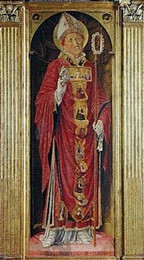
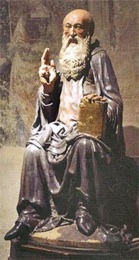
St Juvenal (ca. 1475) St Antony Abbot (1475)
attributed to il Vecchietta signed by il Vecchietta,
dated by inscription
Two works that are now in San Giovenale are associated with il Vecchietta:
-
✴In 1700, two panels depicting, respectively, SS Juvenal and Cassius, and their gilded surrounds were moved from the chapel below the sacristy, which belonged to the Compagnia di Sant' Antonio, to the main part of the Duomo. The panel of St Juvenal was documented again during the episcopal visit of 1708, at which point it was in its current location, on the pilaster at the end of the colonnade on the right, opposite what was then the Cappella di Santa Caterina (now the Cappella della Beata Lucia). However, no mention was made in 1708 of the second panel, and its current location is unknown.
-
The panel depicts the saint, identified by inscription, standing in a fictive niche, holding a palm in one hand and blessing the viewer with the other. The palm suggests martyrdom, although there is little in the hagiographic tradition that suggests that he was martyred. His cassock is rendered in exquisite detail.
-
✴It seems likely that the polychrome wooden statue of St Antony Abbot that is now at the end of the left aisle, which was first documented in 1872 in the Cappella Nuova della SS Sacramento, also came from the chapel of the Compagnia di Sant' Antonio. It has the following inscription:
OPUS LAVRENTI PETRI AL[IAS] VECCHIETTA DE SENIS A CCCCLXXV
the work of Lorenzo di Pietro, called Vecchietta, from Siena, 1475
Scholars also attribute the panel of St Juvenal to il Vecchietta, and suggest that Cardinal Berardo Eroli arranged for him to work in Narni in the period around 1475. It is possible that the statue of St Antony Abbot was originally flanked by the panels of SS Juvenal and Cassius in a single triptych.
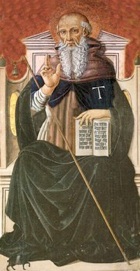
St Bernardino of Siena (15th century)
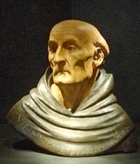
The bust was first documented in 1872 and again in 1898, when it was belonged to the Ospedale dei Proietti della Beata Lucia di Narni. It passed to the civic collection in 1969. It must originally have come from a Franciscan church, perhaps San Francesco or San Girolamo.
Read more:
G. Casio, “La Imago Patroni fra Suggestioni e Permanenze : la Tavola Liturgica del Vecchietta nella Cattedrale di Narni ”, Arte Cristiana, 97 (2009) 199-208
L. Vignoli, “Il Cardinale Berardo Eroli e la Decorazione della Cappella di San Bernardino a Narni”, in G. Benazzi and E. Lunghi (Eds), “Pierantonio Mezzastris: Pittore a Foligno nella Seconda Metà del Quattrocento” (2006) Foligno, pp 193-217
Return to Art in Narni.
Return to “Foreign” Painters in Umbria.



